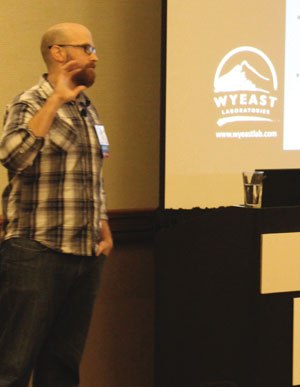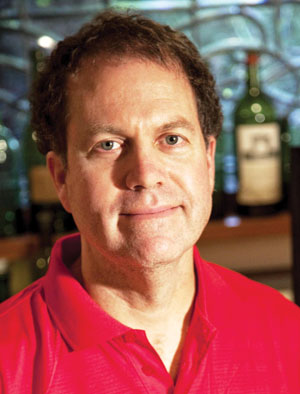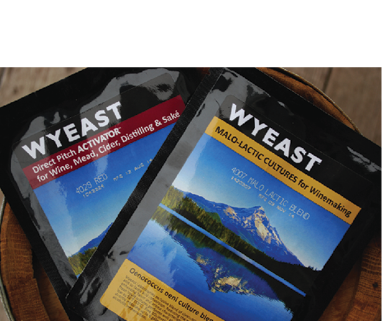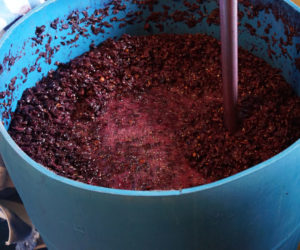As illustrated in the WineMaker Yeast Chart, there are many commercial yeast strains available for home winemakers to choose from. And that list doesn’t even count the numerous other strains marketed and packaged for commercial wineries and then broken into smaller sizes suitable for home winemakers at some retail shops. With all of these options, how should a winemaker go about determining what strain they should choose? Sure, manufacturers recommend styles that their yeast strains may work best with, but that still leaves you with a handful of options. There are many factors to consider, starting with the characteristics you want the yeast to impart on your wine.
For tips on selecting the best strains to get the job done, we asked four experts with various wine and yeast-related backgrounds to give us a hand.
 Shea A.J. Comfort helped start MoreWine! in 2000. Over the next four years he did intensive fermentation research on yeast, oak, malolactic bacteria, tannins, and oxygen. He has been an on-going contract winemaker for Lallemand since 2001, creating yeast and malolactic bacteria trials along with giving technical winemaking presentations throughout the country. Since 2007 he has been working with individual winemakers with his independent winemaking consultation business.
Shea A.J. Comfort helped start MoreWine! in 2000. Over the next four years he did intensive fermentation research on yeast, oak, malolactic bacteria, tannins, and oxygen. He has been an on-going contract winemaker for Lallemand since 2001, creating yeast and malolactic bacteria trials along with giving technical winemaking presentations throughout the country. Since 2007 he has been working with individual winemakers with his independent winemaking consultation business.  Michael Dawson is the former Brand Manager at Wyeast Laboratories, Inc. in Odell, Oregon, which provides fresh, pure liquid yeast to hobbyists and professional winemakers and brewers around the world. Before coming to Wyeast, Michael worked as the Brand Manager and Senior Product Development Manager at Northern Brewer in St. Paul, Minnesota.
Michael Dawson is the former Brand Manager at Wyeast Laboratories, Inc. in Odell, Oregon, which provides fresh, pure liquid yeast to hobbyists and professional winemakers and brewers around the world. Before coming to Wyeast, Michael worked as the Brand Manager and Senior Product Development Manager at Northern Brewer in St. Paul, Minnesota.  Pat Henderson is the Senior Winemaker at Kenwood Vineyards in the Sonoma Valley of California. In addition to his work at Kenwood, he has been a winemaking instructor at Santa Rosa Junior College for more than two decades and is also the co-author of the textbook About Wine (Delmar Learning, 2007).
Pat Henderson is the Senior Winemaker at Kenwood Vineyards in the Sonoma Valley of California. In addition to his work at Kenwood, he has been a winemaking instructor at Santa Rosa Junior College for more than two decades and is also the co-author of the textbook About Wine (Delmar Learning, 2007).  Kevin Lane joined Fermentis (Red Star) in 2013 as the Technical Sales Manager for the United States and Canada. He has been working in the potable alcohol industries for suppliers or as a brewer for the last 10 years and has been passionately pursuing knowledge about all potable alcohol production.
Kevin Lane joined Fermentis (Red Star) in 2013 as the Technical Sales Manager for the United States and Canada. He has been working in the potable alcohol industries for suppliers or as a brewer for the last 10 years and has been passionately pursuing knowledge about all potable alcohol production. How can yeast selection shape a wine or how can you use different strains of yeast to design a wine?
Shea A.J. Comfort – Next to the actual fruit, yeast strain selection is the most important element that will determine the quality and style of the wine. Each strain has its strengths and weaknesses par rapport to their ability to structure, express fruit, and ferment. If we take the time to understand these, we are creating a very powerful base to draw from when we set out to create our wines.
Michael Dawson – Depending on choice of strain and fermentation protocols, yeast can be used to enhance or accentuate varietal or process-driven character (as in a big, complex, oaky red); or it can basically just do the work of fermentation and then get out of the way (as in a light, crisp, approachable white).
Pat Henderson – The type of yeast that you use will certainly affect the flavor of your wine. Think of yeasts as one of the tools in a winemaker’s kit that can be used to tweak the flavor in a certain direction or avoid problems that might develop during fermentation.
Kevin Lane – Yeast by itself does not make a good or bad wine. The quality of the raw material is the essential point. In this context, yeast can contribute to design the wine we want and to create some value. One example is the aromatic richness. Yeast can contribute with fermentative aromas, mainly esters, or contribute to release some others, like volatile thiols or terpenes. Neutral yeast is not necessarily a bad choice. Sometimes the richness of the varietal would not like to be altered. In addition, yeast can contribute to polyphenol and color extraction, and some sweetness with producing different levels of glycerol. Some yeasts are more prone to autolyze and contribute better to mouthfeel than others.
Why is it important to match a yeast strain to grape variety, and how should a home winemaker go about doing it?
Shea A.J. Comfort – Each strain has a certain type of ester profile, both in how much of the fruit is expressed, as well as the actual qualities of the fruit itself. To illustrate: If a yeast is known for strong tropical aromas of pineapple and guava, you may not want to pair that with Cabernet Sauvignon.
Michael Dawson – If I could suggest a slight rephrasing: It’s important to match yeast strain to desired outcome — the winemaker’s vision of the finished product. There are certainly some tried-and-true combos of yeast strain with a specific varietal or style, but there may be occasions where we want or need to color outside the lines too.
If we have a vision for the finished wine before the grapes are even picked — flavor, color, mouthfeel, etc. — then the choice of strain (or strains, because maybe we’re blending), and all the organoleptic qualities it provides, along with other techniques like cold maceration, malolactic fermentation (MLF), barreling, etc., is a means to help realize that vision in the glass.
So: Visualize the wine, then use the manufacturer’s specs to select the strain(s) that best matches it.
Pat Henderson – Although there are no hard and fast rules, some strains of yeast work particularly well with individual varieties. Some yeast will promote fruity or varietal character useful when making wines from aromatic varieties like Gewürztraminer or Sauvignon Blanc. If making wine from high-Brix grapes, using a yeast strain that can handle high alcohol will help to avoid a stuck fermentation.
Kevin Lane – We think it is important to match a yeast strain with the type of wine we want to produce and not to strictly base our decision on the grape variety. What does this mean? When you go through a chart with recommendations, you normally see many yeast strains matching with different grape varieties. That way of presenting the information limits our creativity and our possibilities. We encourage winemakers to base their decisions on yeast characteristics and type of wine they want to produce. What are the important characteristics to consider? Fermentation kinetics, production of fermentative aromas, aromatic neutrality, nitrogen dependency, capacity to reveal primary aromas (coming from grapes), temperature tolerance, contribution to mouthfeel, autolysis capacity, etc.
What is the most important thing a home winemaker should consider when choosing between similar yeast strains that both have the ability to ferment to dryness?
Shea A.J. Comfort – Most strains, when following good fermentation protocols (balance the must before you inoculate, proper nutrition with organic forms of nitrogen, temperature control, etc.) will ferment to dryness. Best to choose complementary strains that will create greater complexity than similar ones, no?
Michael Dawson – Which one better suits your vision for the finished wine? Which is most suitable for the style or varietal? Which will work best with your equipment and process? Is one better adapted than the other for your specific must conditions (e.g., nutrient level, planned fermentation temperature, etc.)? What’s worked well for you in the past?
Pat Henderson – Assuming the yeast you are using will give you a complete and clean fermentation, look for a yeast strain that will bring out the best in your wine by emphasizing the grapes’ varietal character. Also it is best not to use a yeast that is a vigorous fermenter if you don’t have a high-sugar must because it will ferment too quickly, this will reduce the final wine’s aroma and may cause problems with excess heat from the fermentation.
Kevin Lane – Focus on the type of wine you want to produce, and then select the most appropriate yeast. Openness is essential. Try to focus your decision on the yeast characteristics. This concept is challenging, because you can arrive at interesting conclusions. For example, if you want to make a high quality Chardonnay fermented in oak barrels, why not choose a red wine yeast promoting mouthfeel and yeast autolysis. If temperature is not an issue, why not? Typical questions to base our decisions are: Do I want to promote polyphenol extraction? Do I want to increase the aromatic complexity with fermentative aromas? Do I want to reveal specific aromas from grapes? Do I want a fruity, fast consuming wine or an oak aged wine? Of course, all the decisions are made assuming we have the correct grape.
How important is it to consider a yeast strain’s fermenting characteristics in winemaking? I.E. how important are: Rate of fermentation, volatile acidity (VA) production, SO2 production, malolactic (ML) compatibility, nutrient requirements, etc.?
Shea A.J. Comfort – If you have control over the basics, and understand how to care for the yeast, then all strains are possible, and problems are avoided (usually). If you don’t or can’t do so, then adjust accordingly: Pay attention to temperature tolerances and nutrition ratings especially. However, even “easy” strains will make better flavors and aromas if you care for them well and feed them correctly. It’s best to learn to take care of the fermentation in any case.
Michael Dawson – I think it’s very important — but I’m fussy, and I work for a yeast lab, so YMMV (your mileage may vary). I think it’s important to know what you’re getting into (particularly in terms of nutrient requirements, SO2, and the other factors you mention) so you can be prepared to provide the yeast with what it needs for a successful ferment. Will you need to supplement with nutrients? Will you need to cool the fermentation to keep the fermentation rate from ripping or can it free rise, or does it even need external heat? And so on.
Pat Henderson – As mentioned earlier, fast fermenters will help you to get your wine dry but can cause problems if they are used on a wine that does not really require one. As far as the other parameters like (VA, SO2, etc.), they are usually not a worry with commercially available yeast. However all yeast, whether native or purchased, will benefit from nutrients.
Kevin Lane – Extremely important. If we know how our yeast behaves, we can implement the proper process in order to achieve the desired wine. However, we always need to consider that the values provided by suppliers are just references. These values are obtained under certain specific conditions and just inform the relative behavior within the different strains. In general, these values do not contemplate the influence of some other parameters. For example, a yeast strain characterized as a low volatile acidity producer will probably produce high volatile acidity when must conditions favors its production.
What are your thoughts on selecting a yeast strain based on the ideal conditions where a winemaker will be fermenting (temperature, etc.) vs. selecting the ideal yeast strain for the wine style they are making?
Shea A.J. Comfort – If you are fermenting in a situation where you can’t control the temp (don’t have the proper cooling equipment), choose the strain that is best rated for heat tolerance and a lower/medium fermentation rate that is appropriate for your grape and style. Everything else is easy to correct for and adjust, so there is no excuse for any other issues.
Michael Dawson – This is a bit of a nature vs. nurture question . . . choosing strain based on style vs. actual conditions — both important, both fairly situational. I would say that in most cases a “non-ideal” or nontraditional strain that enjoys ideal fermentation conditions would trump an “ideal” strain for a varietal or style that’s coping with non-ideal conditions.
For example – a Riesling must inoculated with a traditional German white strain (an ideal choice on paper) that’s fermented at 85 °F (29 °C) (non-ideal) is probably going to be further from the Platonic ideal of a Riesling than the same must fermented with, say, a Champagne yeast at 60 °F (16 °C).
Pat Henderson – Obviously you want to make the most flavorful wine possible so you would like to use the yeast strain that showcases the best of the variety, just remember that if fermentation has problems they might outweigh any positive aspects you might get. I would recommend if you are using a yeast strain that might have a hard time fermenting be sure to baby the yeast with lots of nutrients, a large inoculum, and a gentle rehydration.
Kevin Lane – Both are essential and the best is to consider both approaches to make the right decision. Choosing the ideal conditions where the winemaker will be fermenting will contribute to obtain predictable and good fermentations, which is essential to avoid undesirable attributes in the wine. Fortunately, usually there’s more than one option. Some of them can contribute to shape the wine in the correct direction you would like to go.
If time is not an issue, when/why might you want to choose a slower fermenting yeast strain from a faster fermenting one?
Shea A.J. Comfort – Temperature is more important than time. If you have a fermentation that is moving along and the temperature is not out of your ideal range, then that will make nice wine. If you have higher temperatures or a heat spike that creates more volatile sulfur compounds (H2S, etc.), this makes a poorer wine. It is worth remembering that organic forms of nitrogen (Fermaid-O, for example) are more complex and are broken down slower than Di-ammonium Phosphate (DAP), so by using them you can really limit heat spikes and run away fermentations. This is a nice bonus you get from using proper nutrition.
Michael Dawson – To ensure preservation of bouquet and varietal character in a cool white wine fermentation, or to help promote extraction of compounds from the skins in a red fermentation.
Pat Henderson – Slow and steady fermentations will have more fruity aromas because they will blow off less of the wine’s natural aroma compounds. Also if you wish to make a wine with a little bit of residual sugar it is best to use a yeast that is less tolerant to temperature or SO2 so it will be easier to arrest the fermentation before it is finished.
The only factor governing this decision should be the type of wine the winemaker wants to produce. Time should be the correct one for the type of wine you want to produce.
How practical is it for home winemakers to experiment with different yeast strains? Are there any ‘rules of the road’ they should follow?
Shea A.J. Comfort – I feel it is a practical necessity. Be very clean, and vigilant with both SO2 and inert gas use. The smaller the lots, the greater the impact of oxygen exposure.
Michael Dawson – Home winemakers have a fantastic capability to do small-scale experiments and bench trials with different strains. It’s a great tool to expand your understanding of your unique winery, process, equipment, fruit, etc., and creates the potential to foster more complexity through blending. Take copious notes!
Pat Henderson – It is pretty easy to play with yeast, small packages of yeast do not cost too much and it is an easy way to add complexity to wine. You can try a mixed culture or use different yeasts in different carboys or barrels and then blend them after fermentation is complete. I think that the most important rule is to follow the manufacturer’s instructions for mixing up the yeast. If yeast is not rehydrated (woken up) properly you can kill most of the yeast cells before they even get into the wine.
Kevin Lane – We learn a lot from home winemakers and homebrewers. They have the possibility to experiment with a lot of combinations. This is one of the most fascinating aspects of this activity. The only rule is to keep the creativity and be open to new experiences. Try to know more about the yeasts and you will be surprised with the results. Try to base your decisions on yeast characteristics and type of wine you want to produce and think out of the box.
What are some good yeast experiments home winemakers can try to develop their palates?
Michael Dawson – Try the same must, with the same fermentation conditions, using different strains — split the juice and/or fruit between a few different tanks or carboys or jugs, and inoculate with different strains.
Or use the same strain in the same must across a variety of fermentation conditions — different temperatures, with or without MLF, different types or levels of oak, etc. Again, take copious notes!
Kevin Lane – I would recommend fermenting the same must with diff-erent wine strains. You will better understand the differences within yeast strains planning comparable trials, based on the same exact must. In fact, do not underestimate the power of the blend. You can balance your wine tremendously through blending. In fact, this is an essential practice in winemaking.
What are your thoughts about the use of cultured yeast vs. native yeast?
Shea A.J. Comfort – Native fermentations always runs a risk of potential off flavors and aromas, especially if we are looking at low/no SO2 dosages in the must to favor them. Lots of potential problems with various microflora. For myself, I prefer multiple cultured strains, in different fermenters and blending afterwards.
Michael Dawson – “Natural” fermentation with wild yeast has a lot of cool factor and tradition; it allows the possibility of a unique, complex product, but it can have a steep learning curve and higher risk of things going wrong.
Fermentations with cultured yeast is the dominant practice these days and it has the advantages of predictability, repeatability, and the “known quantity” factor — lab specs let the winemaker really dial in on what will work best for their particular ferment.
Pat Henderson – Either method will work, you may get some unique flavors with native yeast but you also expose yourself to some risk. I have tasted dozens of native vs. commercial yeast fermentation trials and it seems like about two out of three times the commercial yeast tastes better. You have to remember that commercial yeast strains are just native yeasts that were selected for having superior fermentation characteristics and flavor and then propagated for sale.
Kevin Lane – Usually, when yeast occur properly, native yeasts may contribute to obtain more aromatic complexity. These fermentations start normally with non-Saccharomyces yeasts, which are present in the grape skins. However, these yeasts are much more sensitive to ethanol than Saccharomyces spp., who finally take control of the fermentation. Spontaneous fermentation is produced by the successive colonization of yeast species. The way the different species colonize the must depends on many factors and do not usually occur in a predictable way. In addition, in some cases it can fail and stuck fermentations can occur or off flavors can result.
On the other side, cultured or commercial yeast strains are inoculated at high concentration before the fermentation starts. If well managed, the inoculated strain will prevail in the must, imprinting its characteristics to the wine.
Consistency and predictable results are the main advantages of using commercial yeasts. This is the practice we recommend to follow. In addition, as mentioned before, the power of the blend should be considered to shape the final wine. Fermenting the same must with different yeast strains in different containers can lead to the possibility to obtain innumerous combinations through blending, according to the winemaker’s criteria.
What are your thoughts about the concurrent use of bacteria and MLF and yeast fermentation?
Shea A.J. Comfort – Co-inoculation, if understood correctly, is a great tool and works really well. The same yeast/bacteria pairing will make different wines depending on whether they are sequentially or co-inoculated. Co-inoculations are more soft and fruit-foreword, sequentials are more complex and structured, in general.
Michael Dawson – Co-inoculation of yeast and malolactic bacteria can be a time-saver by eliminating the sometimes leisurely duration of a post-alcoholic fermentation MLF; and it helps the bacteria avoid some ad-verse post-fermentation conditions like alcohol concentration, nutrient depletion, etc.
Conversely, you have to be careful about initial sulfite additions to avoid inhibiting the ML bacteria, which can create some risk of other microbes taking hold in the must; and there can be a risk of acetification by the ML bacteria if the yeast slows or stops mid-fermentation.
Pat Henderson – We have been doing this for a while at our winery and have found it works very well, just be sure to inoculate with malolactic after the alcoholic fermentation is going strong.
Kevin Lane – The MLF concurrently with the alcoholic fermentation (AF) can reduce the vinification time and can help protect the wine from spoilage. It is well accepted that bacteria inoculated in must performs better than those inoculated after AF. ML bacteria can adapt better to increasing levels of ethanol in the must and complete the MLF faster. However, interferences with the AF should be seriously considered, since ML bacteria can affect it negatively. In addition, there is a risk of potential increase in VA.
We believe that co-inoculation could be a useful tool for winemakers, but not necessarily needed in most cases, and is sometimes very risky. We strongly suggest not to follow this practice without any experience.
Do you have any other advice about choosing winemaking yeast strains?
Shea A.J. Comfort – Take the time to run trials and you will be rewarded.
Pat Henderson – Try a lot of strains and figure out which work best for the wine you are making.
Kevin Lane – Have fun with it! There are no regulations on what you can and cannot try when choosing a wine yeast (or other yeast) at home. Home wine is not subjected to the same, strict legal guidelines as commercial wine. The important thing for a home winemaker, is to enjoy the process and the end results. Take into consideration as much information as you can about different wine yeast strains and apply that to what you want in the end!




